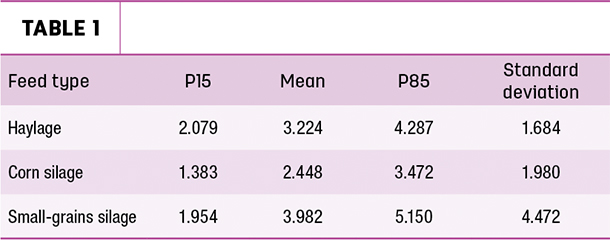Every year, fermentation shrink, or forage dry matter (DM) loss, robs farms’ feed inventory without leaving a trace. Poof, tonnage fed comes out short of tonnage stored. Maintaining valuable nutrient content for feedout is a constant battle with the variables that lay waste to ensiled feeds.
Research estimates predict forage shrink loss per year in harvested U.S. forages is 14%, which corresponds to approximately $3 billion of feed. In a year when feed prices are rising and experts are forecasting forage shortages, minimizing the disappearance of valuable farm-grown feeds should be top-of-mind. This is once again an area where dollars can be reclaimed and losses avoided.
Dr. Limin Kung of the University of Delaware suggests that it is difficult to preserve a forage without seeing 10% DM loss. If this is true under the best conditions, how high does that loss value become for poorly fermented or poorly managed bunkers or drive-over piles? Research has shown some range as high as 25%.
The real costs
A few years back, I was asked to help conduct pre-harvest meetings on a few large dairies. During the discussion of bunk management and reviewing how much silage was pushed by the pack tractor after truck unloading, we realized quickly that an additional tractor was needed to achieve the proper density. Due to associated costs, this recommendation was met with some resistance. Then one of the managers asked the cost of not adding the second tractor.
Without knowing exactly what additional DM would be lost, we figured out how we could negate 3% of fermentation shrink losses. For the aforementioned dairy, that meant they would need to plant an additional 150 acres of corn. However, the now somewhat flustered and frantic owner of the dairy proceeded to share that the additional costs associated with 150 extra acres of corn would be in excess of $200,000. A second pack tractor was promptly added.
For most forage managers, 3% shrink may not mean 150 additional acres of corn silage are needed. But the fact remains: Fermentation shrink typically equates to a larger dollar amount than we think. Helping any dairy realize the true cost of fermentation shrink can help prompt more open discussion among all their consultants around management practices that affect this.
Creating benchmarks
While the importance of capturing and minimizing fermentation shrinks seems apparent, estimating on-farm forage shrink loss to create benchmarks has proven difficult. Unlike purchased feeds that are fairly consistent and dry, fermented feeds offer variability across the fermentation process.
In 2015, Dr. John Goeser (Rock River Laboratory animal nutrition, research and innovation director), along with two other research colleagues, conducted a meta-analysis and published a paper in The Professional Animal Scientist. This paper ultimately shared a predictive equation to calculate fermentation shrink based on the fermentation profile of sampled forages.
Keep in mind that the value reported is based only on the fermentation profile; thus this value is a partial value compared to the total fermentation shrink or DM loss for that forage.
Table 1 showcases the average forage shrink for the typical feedstuffs seen coming through Rock River Laboratory in 2020.

These measurements are based on the aforementioned predictive equation. Corn silage averages 2.5%, haylage averages 3.3% and small-grain silage averages 3.9%. However, in some cases, I have seen sloppy wet small-grain silage, with high ash content, test as high as 11.7% fermentation shrink.
Managing the shrink adversary is best done when there is a starting point. Creating benchmarks and building goals from these can help establish forage management strategies and drive improvement. Using a shrink prediction isn’t perfect, but it offers a place to start and springboard to guide both forage managers and consultants toward tools that can help.
Improvement factors
We know that shrink starts in the field, so from there how can forage managers get closer to minimizing the fermentation shrink number?
1. At harvest, ensure the right stage of maturity before cutting. This also means putting the crop in at the right moisture for the storage structure utilized. Along with the appropriate cut length, these points are critical to proper ensiling and limiting oxygen.
2. Harvest quickly and fill the storage structure without providing much time for oxygen exposure, but don’t shortchange density. Be sure to get the forage packed appropriately to squeeze out oxygen. This will speed the fermentation process and help to avoid sacrificing forage nutrients.
3. Use a well-researched inoculant or additive to help aid in the fermentation process and preserve forage nutrients.
4. Avoid soil contamination (ash). Ash/soil contamination, which contains minerals, acts as a buffer in forage and slows the fermentation process – adding to the nutrient loss in the forage.
5. Keep oxygen out. Limit oxygen during and after fermentation. Routinely check for holes in bags or tarps covering the forage, as oxygen exposure will allow molds and yeast to grow and feed on the forage nutrients. Don’t expose more forage than necessary to oxygen before feeding. For instance, avoid knocking down more forage in a bunker, trench or pile than will be fed that day.
Minimizing shrink losses and preserving forages through feedout is something all managers can get behind. While the steps may seem tedious, the reward of money saved when future feed doesn’t just disappear is great. As many approach the first forage harvests across the U.S. [this season], now is the time to take the reins and minimize fermentation shrink in 2021.
References omitted but are available upon request by sending an email to the editor.










